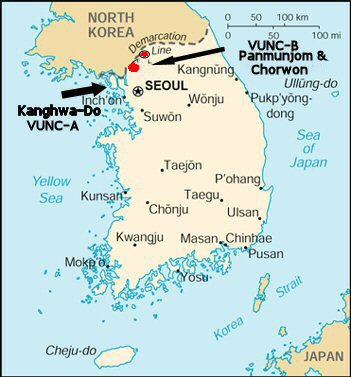
 |
Little has been published about the role of the 14th PsyOps and 7th Group in the operations of the Voice of The United Nations Command (VUNC) in Korea. Initial Accounts in 2004 and 2005 by Russell Kucharski, Richard Hardy, Bob Richards, and Tom Pry provided important history and understanding of Psyops in Korea during a period from 1957-1963.
Further research revealed that VUNC under the command of the 14th PsyWar Battalion (B&VA) continued as the 7th PsyOps Group (reorganization in 1965) and operated until the Group was deactived in 1974 and then moved to the active reserves in 1975. It was also determined the 14th VUNC lineage actually began during the Korea War.
The 'Historical Profile" of the 7th Group indicates the Korean War 1st Radio Broadcasting and Leaflet Bn (1st RB&L) was a predecessor to Broadcasting and Visual Activity (B&VA) and the 14th Radio Broadcasting and Leaflet Bn (14th RB&L) that were reorganized to the 14th PsyWar Bn in 1958.
The PsyWarrior reports the origin of VUNC and the role of the 1st RB&L:
An ambitious network, supervised in 1950-51 directly by PWS (Psychological Warfare Section) and thereafter by the 1st RB&L Group, became known and recognized as the Voice of the United Nations Command. The Korean Broadcasting System (KBS) and the Japan Broadcasting System (JBS) transmitted on a cooperative basis, with the U.S. Government buying air time. The 1st RB&L Group's radio unit furnished programming assistance through key stations in Seoul (KBS), Taegu (KBS), Pusan (KBS) and Tokyo (JBS). In addition, the Group furnished technical assistance to KBS in order to keep as many as twelve network stations on the air.
Alfred H. Paddock Jr., lists the duties in greater detail in U.S. Army Special Warfare, University Press of Kansas, 2002:
The 1st RB&L Group was specifically designed to conduct strategic propaganda in direct support of military operations. Directed at enemy forces, populations, or enemy-occupied areas, strategic propaganda was intended to further long-term aims. The Group supervised a radio station network known as the Voice of the United Nations and often produced more than 200 million leaflets a week disseminated by aircraft or by specially designed artillery shells.
During the time period of 1957-63 there were four broadcasting sites of VUNC in Korea. One of those sites was relocated in 1962. Headquarters company was located in Seoul and consisted of quonset hut barracks and mobile/fixed radio broadcasting facilities. A second smaller site (VUNC-A) was located near the DMZ on Kanghwa-do Island in the Yellow Sea and was accessible only by Military ferry. Quarters and Food were provided by the 226 ASA located near access road to ferry. This site had a powerful 50 KW General Electric transmitter with directional antenna.
A third site, VUNC-B was originally located near Panmunjom on the Imjin River but was moved to the Chorwon Valley in 1962 (4th site). The original Panmunjom site used a 5 KW mobile tranmitters but the Chorwon and Seoul sites used 10 KW tranmitters. I was involved in the intitial building phase of the newer facility in the Chorwon Valley as part of my TDY from the 14th on Okinawa.
Tom Pry who was a broadcast specialist at VUNC in Korea from 1957 to 59 said the main VUNC studios were located in Japan prior to reorganization to the 14th PsyWar Bn in 1958, but were moved to Okinawa about 1958 .. Tom indicated the VUNC studios in Japan were the same ones used by the infamous Tokyo Rose during WWII. Some VUNC broadcasts originated from Korea but most were recorded in Japan or Okinawa after 1961 and rebroadcast to Korea and other countries from Deragawa Okinawa by the 16th PsyWar Company.
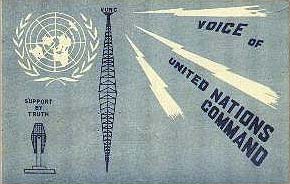 |
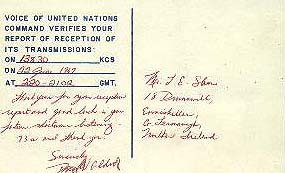 |
|---|
VUNC broadcasts included requests for listeners to send verification of receiving those broadcasts. These requests were often in the form of receipts called QSL cards. I have found only one surviving example of a card and would appreciate any information or documentation concerning any others
 |
 |
|---|
It is important to note for the historical record that the Tori Patch was worn only briefly prior to 1961 in Korea because of Korean reaction to the hated Japanese symbol. One of the 1960 pictues provided by Bob Richards shows VUNC personnel wearing the 8th Army patch. Bob said the Tori patch was worn for about three months in 1960 prior to the change to the 8th Army patch. (Bob Richards with Tori Patch 1960). The Tori Patch was once again worn in 1961.
I remember one incident during my TDY to Korea in 1962 when several old Korean men spit at us. We were told the Koreans were spitting at the Japanese symbol and not at us. It is not known but suspected that the 1st RB&L also wore the 8th patch durng the Korean War.
Psyop activity continued in Korea with the reorganization of the 14th PsyWar Battalion to the 7th Group in 1965. All personnel of the Korea detachments were redesignated as the 24th PsyOps in 1968.
Bill Winstead (6/13/05) indicated that while he was assigned to Kangwa-Do Island in 1971, VUNC was changed to VOA or Voice of America. He also reported that with the reassignment of the 7th Group to the Active Reserves in 1975, the facilities in Korea were deactived in 1974.
I was assigned to the 24th Psyop Det in Korea from 1971 unill it deactived in the beginning of 1974. I was stationed for a year each at both the "B" site at Chorwon and the "A" site on Kangwha-do Island. From my understanding when I got there it had just recently changed over from VUNC and our mission became VOA. We transmitted to the north as well as distributed Chi-u Magazines to the villages around the DMZ. At both sites there were only 3 of us Americans with ROK army perimeter guards and Korean generator men and korean technicians.
Further history of the Korea Detachments is presented in the form of pictures and accounts from individuals who served from the late 50's until the early 1970's. Some of these accounts also appear elsewhere in Main Menu under Personal Accounts
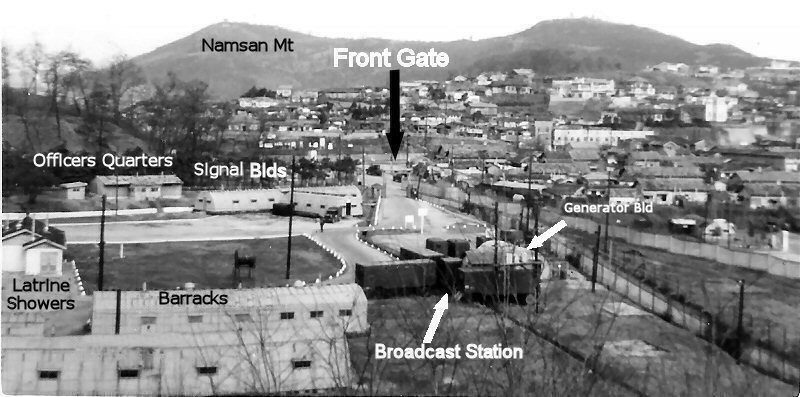
Headquarters Company was located in Seoul near Namsan Mountain. The facility consisted mainly of quonset huts for quarters and offices and mobile radio equipment that was mostly fixed in position.
The main broadcast transmitter was A five thousand watt AM transmitter housed in a semi-tractor trailer. A companion studio van was used for live shows or to replay tapes made in VUNC studios in Japan and Okinawa. Power was provided by a city grid but generators provided power during outages which were common.
Shortwave transmitters, teletypewriters and receivers for receiving broadcasts from Okinawa and elsewhere were also located in fixed mobile units. Towers were used as antennas.
The large compound was fenced and the gate was guarded by Republic of Korean Soldiers.
On 24 April 1962, nine of us were sent TDY from Okinawa to the Korea Detachment in Seoul. Below is part of my account from Account Page.
We did not take any vehicles or equipment on this assignment and were flown to Korea from Kadena to Tachikawa Japan and then on to Kimpo in Korea where we were taken by vehicle to the B&VA Hq located in Seoul.. One of the buildings at Kimpo looked like the war had just ended.
Some of our time was spent learning and using the radio broadcasting and monitoring equipment at the station. Daily radio broadcasts used the call sign VUNC or Voice of The United Nations Command.
The facilities were crude compared to our station on Okinawa.. Most of the equipment, barracks, and mess facilities were in Korean War vintage quonset huts..The huts were heated with oil heaters.. We joked about being treated like Marines since they still used quonset huts at many camps on Okinawa..
We made a number of trips north to the DMZ to visit the AM broadcast station (VUNC) at Kangwa-do Island and to record signal strength readings from our transmitters in Seoul and Okinawa. We traveled by jeep logging over 500 miles during several weeks.. These trips took about 8 hours and were no joy rides since all of the roads were dirt and some in very poor condition.. On one trip with Sgt. Dudek (from Bellaire Ohio) we developed engine problems and had to limp into Camp Casey where we stayed a day until the engine was replaced. Several of us also made a trip to Chorwon Valley where we were involved in the construction of a new VUNC Site-B. An older site at Panmunjom was dismantled.
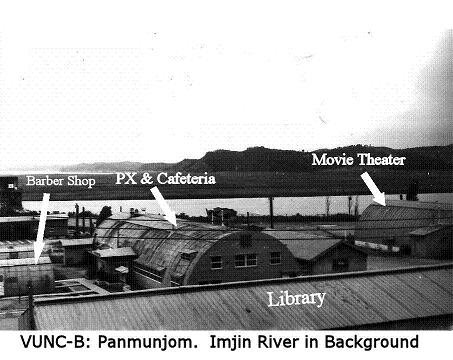 |
|---|
There were two "B" sites with the first and original located in Panmunjom the armistice negotiating site to end the Korean War in 1953. The village of Panmunjom is on the de facto border between North and South Korea. Research has not revealed when the site was first used or who set it up but a good guess would be the 1st Radio Broadcasting and Leaflet Company who served in the Korean War.
Russell Kucharski who was with the 14th PsyWar Bn from 1961-63 is the only person I have found who served at this site which was shut down in the Fall of 1961. Russell shared the following:
The original VUNC-B site was located in the Panmunjom area. There were only 2 bridges to get acorss the Imjin River. We were located in between the two bridges. After crossing, it took 15 minutes to drive to the site. It was located across from CC3, a recreation area for the guys on the DMZ. The bridges had explosive charges and were to be blown if the North Koreans came. We were told we had 5 minutes to cross. We had one carbine for 3 guys, all PFC's. I once asked how we would get out if it took 15 minutes to drive. We were told they would send a helicopter to get us out. (Sure they would!)
We were in an area called the "spoonbill" because if you looked at a map, the river surrounded us, as well as Panmunjom. The two bridges across the Imjin were called Liberty and Freedom. I believe they are still called this today. The only Koreans allowed in the spoonbill were the ones with passes that worked there, like cooks, houseboys, and the ones at CC3. They were all bused in every day. There were no Koreans in the site at night except for an occasional floor show from Seoul.
Our station was just a hut, generator shed, antenna and 5 KW transmitter in a trailer parked along side the hut. We were on a side branch of the Imjin and once in a while you could see a small boat with lanterns come down the river, just before the firing would start. We had a lot of edgy guards. You could usually hear the machine gun fire at night. The radio station made so much interference it came in over the telephones and every speaker for radios, movie theater, etc. Many a drunk GI threatened to wipe us off the air. One time an armored personnel carrier plowed through our little front gate.
I was at the site for 3 months in the early part of my tour, but the site was shut down in Fall of 1961 and all equipment was moved to Seoul. When you (Tim Yoho) came, you were part of the process to locate a new site which was then set up in the Chorwon Valley. There were no other American personnel in that part of Korea except for the ASA compound where you stayed. North Korea was to the front and left of you with mine fields and wild boars setting off some of those mines at night.
The two color pictures below show construction of the Station Hut in 1962 (Tim Yoho).. B&W Photo (Laney Martin) shows completed Compound in 1969. Mts in top picture look smaller because picture was taken at ground level.
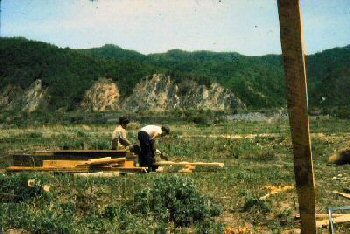 |
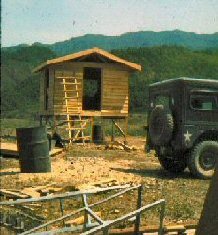 |
|---|
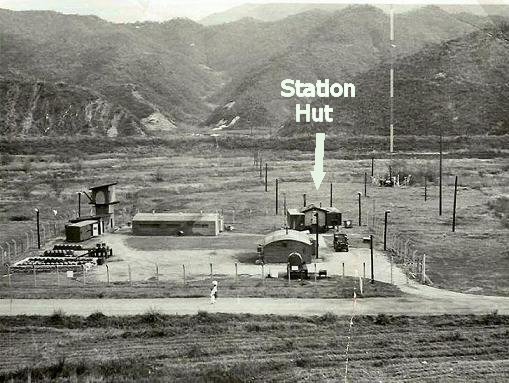 |
|---|
As Russell Kucharski stated above, I was involved in the initial construction of the Chorwon Valley Site in 1962 when a small group of us were sent TDY to Korea. I discussed this in my account of the Chorwon Valley:
We made a number of trips from Seoul to the site of a new AM station under construction in the Chorwon Valley. We were told this was the closest American faciltiy to the DMZ.. Prior to the construction of the new Site-B, the closest American site was an ASA compound a few miles away where we stayed over night during our supervision of the Transmitter site construction. . There were mine fields on either side of the road leading to the site and ROK tanks nearby.. I distinctly remember not being permitted to take pictures of the tanks, the point being made by an ROK soldier who pointed his weapon in my general vicinity and shook his head no.
Being so close to the DMZ We were required to have loaded weapons with us at all times; however, I never thought much of the firepower of an M-1 Carbine..... During one of the nights at the ASA unit we heard gun fire and learned a short while later that two North Korean infiltrators had been killed in a fire fight. One ROK soldier was wounded..
I learned from George Lane ( 9/10/04) that the Transmitter site was still in existence in 1970-71.. George, a civilian electronics engineer, worked as a consultant for the US government , and had visited this site when he was in Korea in 1970-71.
Since Lane's report in 2004, I have received orther accounts of the facility. One of those was from retired SFC Laney Martin who provided picture of completed site above.
I was with VUNC, 24th PSYOP, in 1969 - 1970 at Site "B" Chorwon Valley. I got to Korea in 1969, assigned to AFKN in Pusan but was transfered to VUNC about three months later because of a shortage of technicians. Being a 26T, Television technician, I was not too happy about being assigned to a radio hut. It turned out to be a menorable time up there. I had met a young girl in Pusan and took up living with her, when I was reasssigned, at the village of Taeguanee (I'm sure that is misspelled) that was about 5 miles from Site "B". About a year later we were married while I was assigned to AFRTS Alaska A new tranmitter hut was built while I was there and they took away the two mobile van later.
I went back to Korea in 1973, AFKN, and called Site "B" and got the same tech who worked there before. Never did get to go up there. Had many dreams about that place over the years. One day I would like to go see it again if possible.
In Feb 2013, I received an email from Russell Kucharski who told me he received a copy of an email (below) that a Paul Chalupa sent me. Evidently Paul had sent this mail to an old account of mine and i did not receive the message. Paul was surprised that he found a picture of himself labeled "Unknown at Site". I was also surprised to learn the "Unknown" was Paul and I had taken this picture. He in turn took the picture of me (above: Tim Yoho With Duce & Half driven From Seoul). When I posted those pictures years ago, I had forgotten Paul's name......Another Mystery solved!
Tim,
I was looking at some old slides of when I was in Korea in 1961-62, so for the hell of it I Googled the "radio station VUNC" www.timyoho.com/bvapage/koreafiles/korea-history-det.html . I was quite surprised at the website that popped up. You and some of the guys really did a good job of putting together the history of the unit with pictures and some interesting personal blogs.
I spent about 10 months at the base station in Seoul and then the next six months in 1962 putting in radio station VUNC-B Chorwon Valley. (See my attached photos). Comparing these to the website photos, more work was done after I left the site especially fencing it in. Must be they were afraid of the occasional North Korean coming thru.
More interesting, I found two pictures of myself in the website.http://www.timyoho.com/bvapage/koreafiles/PipelineArticle-62.htm
This from the Army newspaper article when I was at the base station in Seoul.http://www.timyoho.com/bvapage/koreafiles/VUNC-B/UnkTrkKor.JPG
This taken when I was at the VUNC-B site on the DMZ. It was titled "Unknown" since I'm sure it was submitted many years later when the website was developed and it is easy to forget names. I had never seen this photo before.
I remember Russ Kucharski from my time in Korea, as well as, a number of others that are listed in the website roster.
Thanks for putting in the work to develop this website.Paul Chalupa
Holliston, MA
I received a response from Paul Chalupa a few days after I responded to a new email address from him:
Tim and Russ (Kucharski) Thanks for the response.
Tim you are right. I don't remember taking your picture. It's strange what I do remember from back 50+ years ago from VUNC-B. Like when we clearing concertina wire from the site and I found a live grenade; everyone did scatter quickly. Also, initially trying to use "bladder-like" diesel storage tanks on that elevated platform; only to have them roll off and make quite a mess. And of course many others tidbits.
Russ, it was interesting to read the your writeup of the history of BVA after I left in the fall of 1962. I almost extended my tour, but I got homesick after 16 months there. I don't think I would have survived that Army ranger CO PT regime.
Again, I am glad you guys put together the website. Myself, as well as, my kids and their spouses thought it was quite interesting.
I wish you well for the next 50 years.Paul
What might be the last Account of Site-B before reassignment of 7th Group to the Active Reserves in 1975 came from Jim Dillman who was site commander from Sept 1970 to June 1971. Jim must have been present when George Lane visited during this time frame.
I Enlisted in 68, I went to Ft. Monmouth for 9 months of electronic school as 32C20 (Fixed Station Transmitter Repair) and then to Hawaii at Schofield Barracks for 16 months. While there, my unit (Transportables Detatchment) was being disbanded, so I found myself the Generals' driver for USA Stratcom. Easy life then, SP5, no duties, very little work, then orders came from Ft Huachuca (Stratcom HQ) to go to Korea with only 9 months left on my enlistment! The General tried to stop or change orders, but in September 1970, I found myself in the garden country of Korea!
After a couple of days at Youngsan enduring tremendous culture shock, I was shipped out to what our Commander called the Army's best kept secret! Anyway, to make a long story short, it didn't take long to get acclimated to the country, and I left in June 1971, but actually offered to re-up if the Army would guarantee me 6 years at "B" site.
At the site were 6 GI’s and some civilian Koreans. Names I remember are Oh Jin Soo (Guard), pretty boy (generators) , playboy (generators), Mr. Chong (technician)(spoke good English), Mr. Hong (technician), MacKay (GI),Totemeier (GI), Sender, (GI), Frank .....(GI-last name escapes me), .......(GI) (from Texas as I remember), and Crane (GI).
We had quite a time up there including being fired on by a morter round while entertaing some "donut dollies". Seems a ROK practice round fell short and landed right where the old transmitter hut had been. We had already torn it down and used the wood to build a private "hooch" for me. 20 feet to the North and our quonsut would have been trashed! By that time the transmitters had been replaced with 10kw units and we had a new generator building next to the fuel dump with two new 60kw units.
We would go into the mine field behind the compound and dig up the mines, then explode them later. We had an ample supply of dynamite and extra hand grenades and used them, too. We made a lot of improvements to the grounds including a patio and concrete brick wall surrounding it.
Taeqwani was the local village where we would go partying. It was South of the compound a couple of miles. They just got electricity the first week I was at the site & I had my first dinner with the local officials and tasted kimchee for the first time. ASA Camp Alamo was located near there. We were further North than they were by a few miles. Our Korean civilians lived there also.
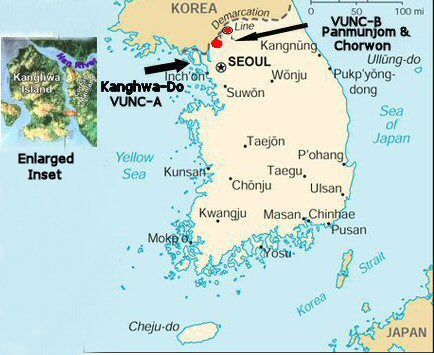 |
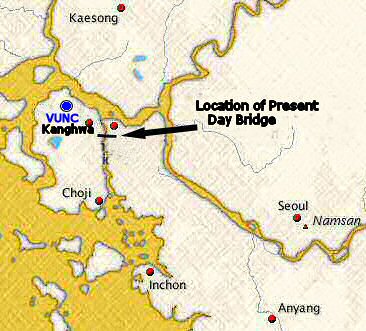 |
|---|
The Facility at Kanghwa Island also known as Kanghwa-do and Ganghwa Island is located in the Yellow Sea at the mouth of the Han-Imjin Estuary. The Island was accessable only by military ferry. Food and quarters were provided by the 226th ASA Company. Today a bridge spans the sea lane to the island.
A permanent building housed the studio and a 50 kw AM transmitter. The station broadcast 18 1/2 hours daily going on the air at 5 pm and continuing through the night until 11:30 the following morning.
Power for the 226th and the VUNC station was provided by four 100KW VUNC generators operated via a contract with the Vinnell Corporation. Russell Kucharski indicated he had to sign for those generators as the VUNC power generator specialist and was responsible for that equipment.
Although VUNC personnel were housed in the 226th USASA compound, the broadcast station was located down the road about half to 3/4 of the way to the ferry landing.
Richard Hardy served as NCOIC at Kanghwa-do from 1962-63. This was during the time I visited the site, but unfortunately I do not remember him.
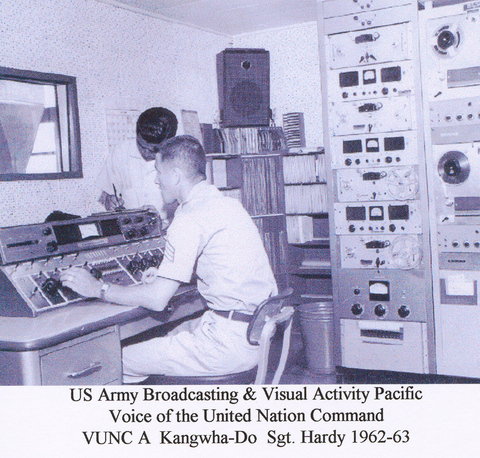
My first duty in Korea was with the 44th Engineers (1959-1960) in Waegwan. In my second tour I was first stationed (July & August) at a Signal Group transmitter site on Okinawa in 1962 but can't remember the name or specific location. I then transferred to USA B&VA Korea Det. VUNC-A on Kanghwa Island. I was NCOIC in part of 1962-1963. My MOS was 272.1 Radio Transmitter Repairman but like many of the personnel had many other duties including running the radio station.
I think my time at VUNC-A was pretty normal with not much happening except the daily activities of running the station. There is one experience I do remember concerning the generators in the ASA (226th) compound. We supplied the generators for use by the ASA and to power our station that was located a distance away from the compound. Once during the winter we could not get our fuel for the generators across the river because the ice was too thick. We had to take the 55 gal drums of fuel oil up the mountain above the fuel tanks for the generators and feed it into a 2 inch hose down the hill to supply them the fuel. It was freezing cold and the hose would keep freezing so we had to go up and down the hill squeezing the hose to keep it flowing. Other than this incident, I had a nice time in Korea. I would love to go back just to see the changes. I don't know anything about VUNC-B at Panmunjom or Chorwon since I was never at either location.
Richard provided a military news article called the "Pipeline" that details operations at the site. The article includes several pictures of facilities and personnel. Richard and I also provided pictures from the Island.
Craig Morris had one the most "recent" (1968-1970) tours of Kanghwa-do prior to its deactivation in 1974:
I went through the Fort Monmouth, NJ Army Electronics School from Jan. 1968 to July 1968 and was trained as a Fixed Station Radio Repairman". I was a PFC at that time. Upon graduation, nine of the eleven grads were sent to Okinawa to the 7th PSYOP. I was there 2 weeks and was sent TDY with 2 others to the Korea detachment and assigned to VUNC A-site on Kanghwa Do Island. This site had a 10 kw transmitter broadcasting to North Korea for the United Nations Command.
After extending my TDY status three times (9 months) they had to send me back to Okinawa or make me permanent. I elected to start a full tour at the KD which allowed me to cut 3 months off my total enlistment, so, I ended up in Korea from July 1968 to May 1970.
Duty in Korea was very interesting since I got shot at twice and accidently burned down a farmers gingsing patch with a parachute flare. I billited with the 226th ASA in the Quonset next door to the NCO club. We had 3-4 assigned to VUNC-A most of that time. I went home as an Sp5.
| 226th USASA Operations Co Korea 1962-1967 | |
| Old Spooks & Spies on Kanghwa-do Korea 1960-62 | |
| Kanghwa-Do Virtual Tour Images |
With the deactivation of the 7th Group on 30 June 1974 and its reassignment to the active reserves in 1975, overt based Psychological Operations by the United States ended in Korea. What covert role the US may have played after this time is not known to me. Perhaps others would care to comment. It is known that the Korean Army has a Special Warfare Command that was created in 1981 but its role in PSYOP is also unknown.
SOURCES (E-Mail)